 Singapore at War!
Singapore at War!
By Bob Hackett
 Map showing dispositions of British Land and Air Units in
Malaya (now Malaysia) in 1941
© Bob Hackett 2013-2016
Map showing dispositions of British Land and Air Units in
Malaya (now Malaysia) in 1941
© Bob Hackett 2013-2016
Revision 1
History:
Before Europeans settled in Singapore, it was a Malay fishing village. In
1819, Sir Stamford Raffles of the British East India Company created the Port of
Singapore trading post. Singapore quickly rose as one of the British Empire's
most important military and commercial centers. In 1824, an Anglo-Dutch treaty
ceded the Port of Singapore and Malaya to the British, and all of Singapore
Island was given to the British. In 1826, the Port of Singapore, Penang, and
Malacca were consolidated as the Straits Settlements, In 1832, Singapore became
the capital of the Straits Settlements.
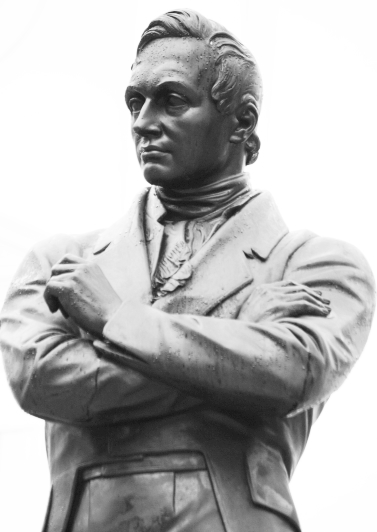
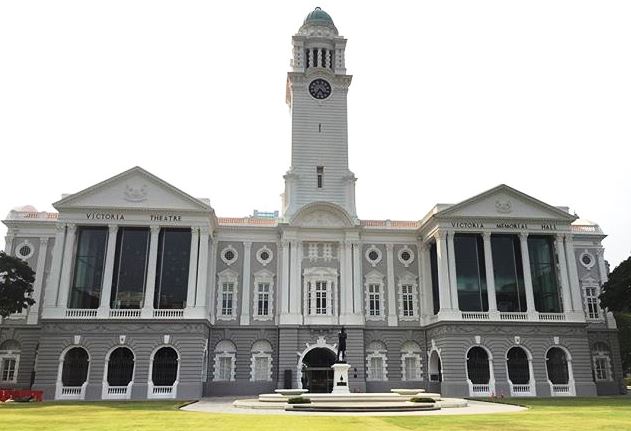 Left:Statue of Singapore’s founder, Sir Stamford Raffles.
Right:Raffles statue stands before Victoria Memorial Hall (now Victoria Theatre and Concert Hall) in Empress Place.
From 1919 to 1941, to deter the increasingly ambitious Japanese Empire in
the Far East, Britain’s Singapore strategy evolved. The strategy required basing
a Royal Navy fleet in the Far East, able to intercept and defeat any Japanese
force heading south towards India or Australia. A well-equipped naval base was
needed. In 1919, Singapore, at the eastern end of the Strait of Malacca, was
chosen as the most suitable location. Originally announced in 1923, the
construction of the base proceeded slowly at Sembawang, at the northern tip of
Singapore, until the Japanese invasion of Manchuria in 1931. During the 1920s
and 1930s, the concept of the “Main Fleet to Singapore” was the cornerstone of
British Imperial defense policy in the Far East. The Singapore Naval Base was
completed in 1939, at a staggering cost of £60 million — equivalent to about £3
billion in 2013. The Singapore Naval Base (also known as HMS Sembawang) covered
21 square miles. Singapore was the major British military base in South-East
Asia and nicknamed the "Gibraltar of the East".
On 8 December 1941, from occupied air and naval bases in Vichy French
Southern Indochina, the Japanese launched aircraft and naval vessels in support
of their invasions of British Malaya (now Malaysia and the Republic of
Singapore) and the Commonwealth of the Philippines (now Republic of the
Philippines). LtGen Yamashita Tomoyuki's IJA 25th Army invaded Malaya from
Indochina, moving into northern Malaya and Thailand by amphibious assault. The
Japanese began bombing of strategic sites in Singapore, and air raids were
conducted on Singapore from 29 December onwards. The 25th Army was outnumbered
by British and Commonweath forces in Malaya and Singapore, but the Japanese were
superior in close air support, armor, coordination, tactics, leadership and
experience. The Imperial Japanese Army Air Force (IJAAF) was more numerous, and
better trained than the second-hand assortment of untrained pilots and inferior
British equipment remaining in Malaya, Borneo and Singapore. After World War I
and two years of World War II, the financally strapped British had no tanks and
few armored vehicles to send to Singapore.
LtGen Arthur E. Percival, General Officer Commanding, Malaya, had 85,000
soldiers, or just over four divisions. There were about 70,000 front-line troops
in 38 infantry battalions—13 British, six Australian, 17 Indian, and two
Malayan—and three machine-gun battalions. The newly arrived British 18th
Infantry Division was at full strength, but lacked experience and appropriate
training; most of the other units were under strength, a few having been
amalgamated due to heavy casualties in the mainland Malya campaign. The local
battalions had no experience and in some cases no training.
Left:Statue of Singapore’s founder, Sir Stamford Raffles.
Right:Raffles statue stands before Victoria Memorial Hall (now Victoria Theatre and Concert Hall) in Empress Place.
From 1919 to 1941, to deter the increasingly ambitious Japanese Empire in
the Far East, Britain’s Singapore strategy evolved. The strategy required basing
a Royal Navy fleet in the Far East, able to intercept and defeat any Japanese
force heading south towards India or Australia. A well-equipped naval base was
needed. In 1919, Singapore, at the eastern end of the Strait of Malacca, was
chosen as the most suitable location. Originally announced in 1923, the
construction of the base proceeded slowly at Sembawang, at the northern tip of
Singapore, until the Japanese invasion of Manchuria in 1931. During the 1920s
and 1930s, the concept of the “Main Fleet to Singapore” was the cornerstone of
British Imperial defense policy in the Far East. The Singapore Naval Base was
completed in 1939, at a staggering cost of £60 million — equivalent to about £3
billion in 2013. The Singapore Naval Base (also known as HMS Sembawang) covered
21 square miles. Singapore was the major British military base in South-East
Asia and nicknamed the "Gibraltar of the East".
On 8 December 1941, from occupied air and naval bases in Vichy French
Southern Indochina, the Japanese launched aircraft and naval vessels in support
of their invasions of British Malaya (now Malaysia and the Republic of
Singapore) and the Commonwealth of the Philippines (now Republic of the
Philippines). LtGen Yamashita Tomoyuki's IJA 25th Army invaded Malaya from
Indochina, moving into northern Malaya and Thailand by amphibious assault. The
Japanese began bombing of strategic sites in Singapore, and air raids were
conducted on Singapore from 29 December onwards. The 25th Army was outnumbered
by British and Commonweath forces in Malaya and Singapore, but the Japanese were
superior in close air support, armor, coordination, tactics, leadership and
experience. The Imperial Japanese Army Air Force (IJAAF) was more numerous, and
better trained than the second-hand assortment of untrained pilots and inferior
British equipment remaining in Malaya, Borneo and Singapore. After World War I
and two years of World War II, the financally strapped British had no tanks and
few armored vehicles to send to Singapore.
LtGen Arthur E. Percival, General Officer Commanding, Malaya, had 85,000
soldiers, or just over four divisions. There were about 70,000 front-line troops
in 38 infantry battalions—13 British, six Australian, 17 Indian, and two
Malayan—and three machine-gun battalions. The newly arrived British 18th
Infantry Division was at full strength, but lacked experience and appropriate
training; most of the other units were under strength, a few having been
amalgamated due to heavy casualties in the mainland Malya campaign. The local
battalions had no experience and in some cases no training.
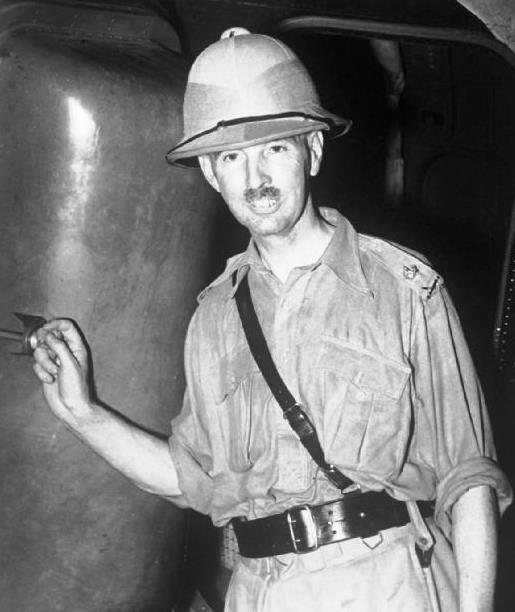
 Left: LtGen Percival, new GOC Malaya, arrriving by air in Singapore in '41. Right:
Troops of the Australian 8th Div arrriving by sea.
LtGen Yamashita's 25th Army had about 30,000 men in three divisions: the
Imperial Guards Division, which included a light tank brigade, under LtGen
Nishimura Takuma, the 5th Division under LtGen Matsui Takuro and the 18th
Division under LtGen Mutaguchi Renya.
On 10 February 1942, British Prime Minister Winston Churchill, cables Gen
(later Field Marshal/Earl) Archibald Wavell, Commander-in-Chief of ABDACOM
(American-British-Dutch-Australian Command) saying: "I think you ought to
realise the way we view the situation in Singapore. It was reported to the
Cabinet by the Chief of the Imperial General Staff, General (later Field
Marshal) Alan Brooke that Percival has over 100,000 [sic] men, of whom 33,000
are British and 17,000 Australian. It is doubtful whether the Japanese have as
many in the whole Malay Peninsula... In these circumstances the defenders must
greatly outnumber Japanese forces who have crossed the straits, and in a
well-contested battle they should destroy them. There must at this stage be no
thought of saving the troops or sparing the population. The battle must be
fought to the bitter end at all costs. The 18th Division has a chance to make
its name in history. Commanders and senior officers should die with their
troops. The honour of the British Empire and of the British Army is at stake. I
rely on you to show no mercy to weakness in any form. With the Russians fighting
as they are and the Americans so stubborn at Luzon, the whole reputation of our
country and our race is involved. It is expected that every unit will be brought
into close contact with the enemy and fight it out ..."
Left: LtGen Percival, new GOC Malaya, arrriving by air in Singapore in '41. Right:
Troops of the Australian 8th Div arrriving by sea.
LtGen Yamashita's 25th Army had about 30,000 men in three divisions: the
Imperial Guards Division, which included a light tank brigade, under LtGen
Nishimura Takuma, the 5th Division under LtGen Matsui Takuro and the 18th
Division under LtGen Mutaguchi Renya.
On 10 February 1942, British Prime Minister Winston Churchill, cables Gen
(later Field Marshal/Earl) Archibald Wavell, Commander-in-Chief of ABDACOM
(American-British-Dutch-Australian Command) saying: "I think you ought to
realise the way we view the situation in Singapore. It was reported to the
Cabinet by the Chief of the Imperial General Staff, General (later Field
Marshal) Alan Brooke that Percival has over 100,000 [sic] men, of whom 33,000
are British and 17,000 Australian. It is doubtful whether the Japanese have as
many in the whole Malay Peninsula... In these circumstances the defenders must
greatly outnumber Japanese forces who have crossed the straits, and in a
well-contested battle they should destroy them. There must at this stage be no
thought of saving the troops or sparing the population. The battle must be
fought to the bitter end at all costs. The 18th Division has a chance to make
its name in history. Commanders and senior officers should die with their
troops. The honour of the British Empire and of the British Army is at stake. I
rely on you to show no mercy to weakness in any form. With the Russians fighting
as they are and the Americans so stubborn at Luzon, the whole reputation of our
country and our race is involved. It is expected that every unit will be brought
into close contact with the enemy and fight it out ..."
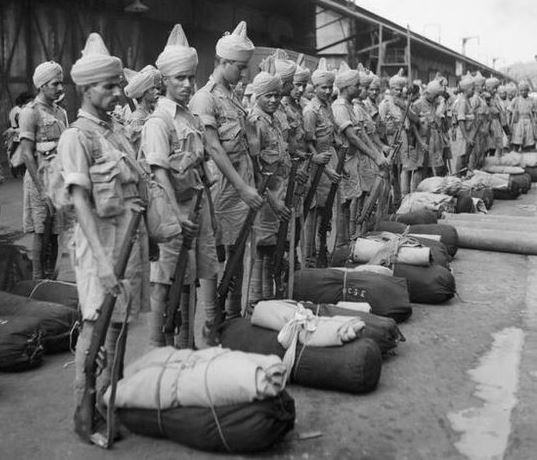
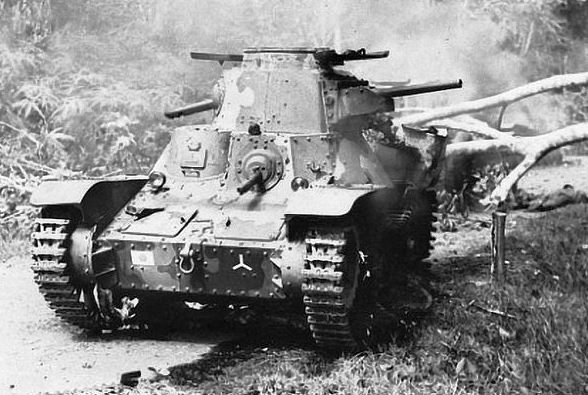 Left: Indian troops arrive quayside in Singapore, Nov '41. Right:
Japanese Type 95 "Ha-Go" tank knocked out in Malaya .
Blowing up the causeway between Johore on mainland Malaya and Singapore
Island delays the Japanese attack for over a week. The fighting in Singapore
begins on 8 February and lasts until 15 February. On 14 February 1942, at about
1300, Japanese soldiers advance towards the Alexandra Barracks Hospital. A
British lieutenant — under a white flag — approaches the Japanese, but is
bayoneted and killed. After the Japanese enter the hospital they bayonet a
number of patients, including those undergoing surgery, along with doctors and
members of nursing staff. This continues for 24 hours, leaving 320 men and one
woman dead. In 1946, LtGen Yamashita is tried for other war crimes in the Philippines,
found guilty and hanged in Manila.
Left: Indian troops arrive quayside in Singapore, Nov '41. Right:
Japanese Type 95 "Ha-Go" tank knocked out in Malaya .
Blowing up the causeway between Johore on mainland Malaya and Singapore
Island delays the Japanese attack for over a week. The fighting in Singapore
begins on 8 February and lasts until 15 February. On 14 February 1942, at about
1300, Japanese soldiers advance towards the Alexandra Barracks Hospital. A
British lieutenant — under a white flag — approaches the Japanese, but is
bayoneted and killed. After the Japanese enter the hospital they bayonet a
number of patients, including those undergoing surgery, along with doctors and
members of nursing staff. This continues for 24 hours, leaving 320 men and one
woman dead. In 1946, LtGen Yamashita is tried for other war crimes in the Philippines,
found guilty and hanged in Manila.
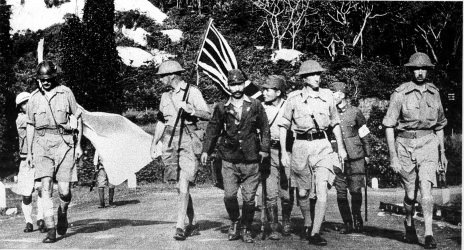
 Left: LtGen Percival,far right, and two Brigadiers carrying a white flag and the Union Jack head towards the Ford Motor factory to surrender. Right:
Japanese tanks clank down Singapore's main Orchard Road after the British surrender.
The British defeat and surrender to the Japanese on 15 February 1942
resulted in the largest surrender of British-led military personnel in history.
About 80,000 British, Indian and Australian troops became prisoners of war,
joining 50,000 taken by the Japanese in the Malayan Campaign. In just seven
days, Singapore, the "Impregnable Fortress", falls. Churchill calls the
ignominious fall of Singapore the "worst disaster" and "largest capitulation" in
British history.
Left: LtGen Percival,far right, and two Brigadiers carrying a white flag and the Union Jack head towards the Ford Motor factory to surrender. Right:
Japanese tanks clank down Singapore's main Orchard Road after the British surrender.
The British defeat and surrender to the Japanese on 15 February 1942
resulted in the largest surrender of British-led military personnel in history.
About 80,000 British, Indian and Australian troops became prisoners of war,
joining 50,000 taken by the Japanese in the Malayan Campaign. In just seven
days, Singapore, the "Impregnable Fortress", falls. Churchill calls the
ignominious fall of Singapore the "worst disaster" and "largest capitulation" in
British history.
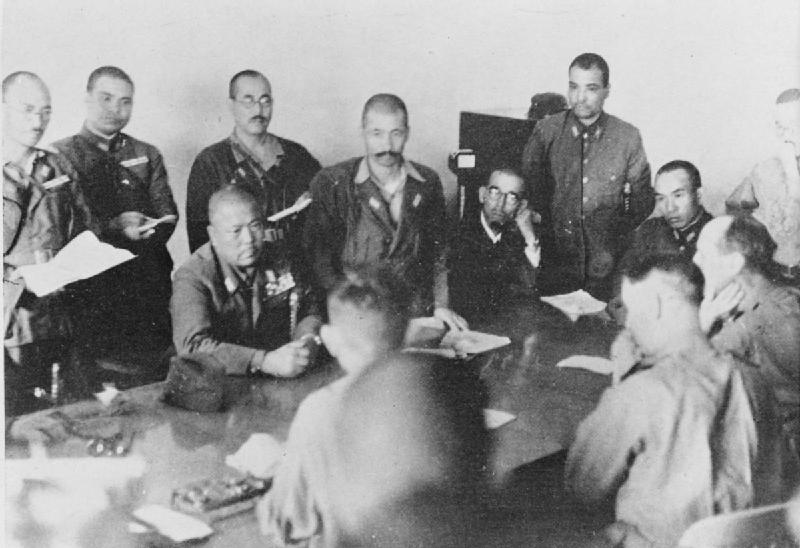
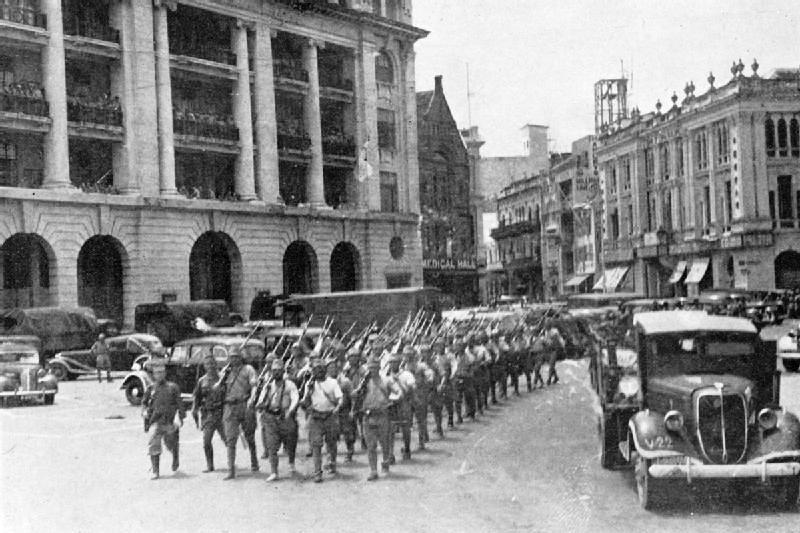 Left: LtGen Yamashita, the "Tiger of Malaya", left at table, demands LtGen
Percival, second from right at table, surrender Singapore Right: Victorious
Japanese troops march through Fullerton Square after the surrender of Singapore.
Naval Facilities:
Singapore Naval Base
Left: LtGen Yamashita, the "Tiger of Malaya", left at table, demands LtGen
Percival, second from right at table, surrender Singapore Right: Victorious
Japanese troops march through Fullerton Square after the surrender of Singapore.
Naval Facilities:
Singapore Naval Base
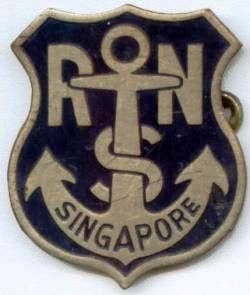
 Badge of Singapore Naval Base and old map of of Singapore
showing location of military and former civilian (Kallang and Paya Lebar)
airfields
On 15 February 1938, the King George VI graving dock (drydock) at the
Naval Base opened and, at almost 1,000 feet in length, was the largest dry dock
in the world. The Naval Base also had the 50,000 ton concrete Admiralty IX
Floating Dry Dock, completed by Swan Hunter in England in 1929, the
third-largest in the world at the time. of its construction and enough fuel
tanks to support the entire British Navy for six months. It was constructed in
seven sections, bolted together and towed to Singapore in two parts because it
was not strong enough to be towed in ocean waves in one piece. Each part
required four tugs, and the average speed was 3.3 knots. The Naval Base also had
a 5,000 ton floating dry dock built in the Netherlands 1924 and purchased by the
Admiralty in November 1939 from the Dutch East Indies and moved to Singapore.
Both floating dry docks were scuttled at Singapore, but raised and re-used by
the Japanese.
Badge of Singapore Naval Base and old map of of Singapore
showing location of military and former civilian (Kallang and Paya Lebar)
airfields
On 15 February 1938, the King George VI graving dock (drydock) at the
Naval Base opened and, at almost 1,000 feet in length, was the largest dry dock
in the world. The Naval Base also had the 50,000 ton concrete Admiralty IX
Floating Dry Dock, completed by Swan Hunter in England in 1929, the
third-largest in the world at the time. of its construction and enough fuel
tanks to support the entire British Navy for six months. It was constructed in
seven sections, bolted together and towed to Singapore in two parts because it
was not strong enough to be towed in ocean waves in one piece. Each part
required four tugs, and the average speed was 3.3 knots. The Naval Base also had
a 5,000 ton floating dry dock built in the Netherlands 1924 and purchased by the
Admiralty in November 1939 from the Dutch East Indies and moved to Singapore.
Both floating dry docks were scuttled at Singapore, but raised and re-used by
the Japanese.
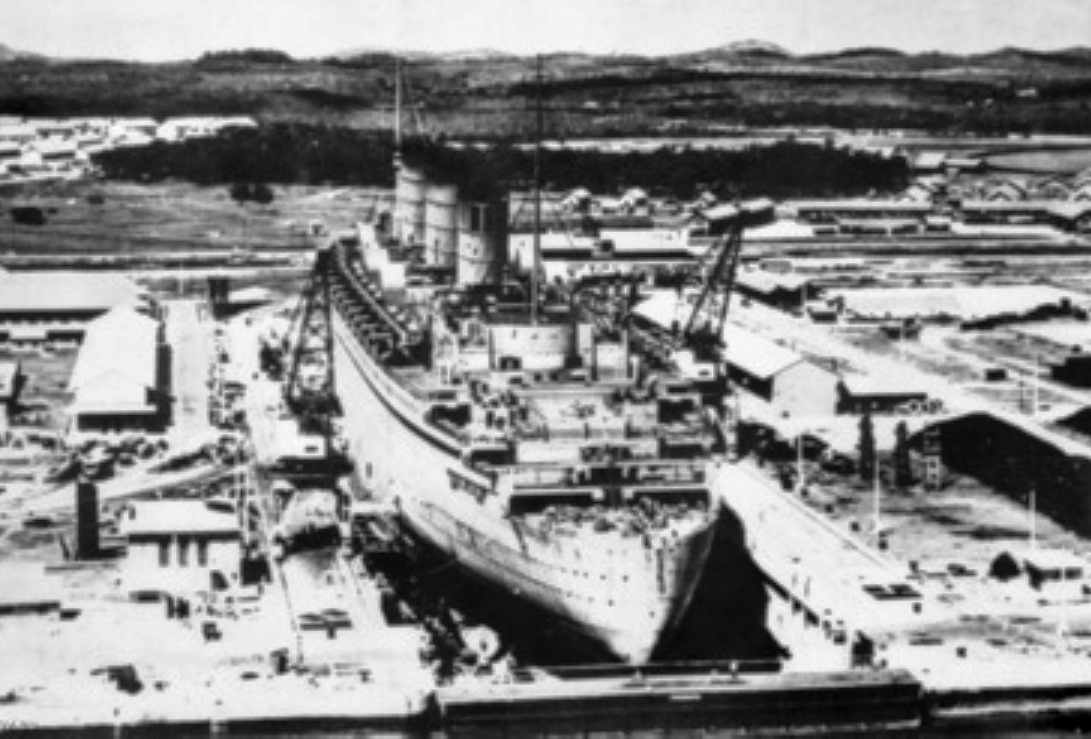
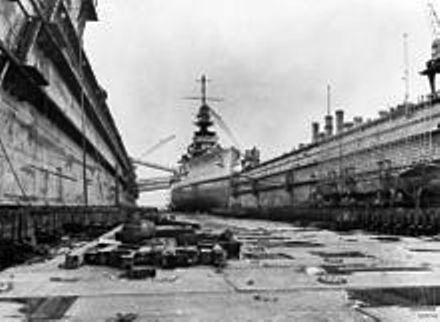 RMS QUEEN MARY prewar in King George VI graving dock (now in Long Beach, CA) and
a British Warship in Admiralty IX Floating Dry Dock
The following entries, while not conclusive, are representative of
activities that took place at the Singapore Navy Base during World War II:
8 December 1941: The Beginning of the Pacific War:
RMS QUEEN MARY prewar in King George VI graving dock (now in Long Beach, CA) and
a British Warship in Admiralty IX Floating Dry Dock
The following entries, while not conclusive, are representative of
activities that took place at the Singapore Navy Base during World War II:
8 December 1941: The Beginning of the Pacific War:
At 1710, Royal Navy
Vice Admiral Sir Tom S. V. Phillips sorties from the Royal Navy Base, Singapore
to attack the Malaya invasion transports with his "Force Z" consisting of
Captain J. C. Leach's new battleship HMS PRINCE OF WALES, Captain (later Vice
Admiral) W. G. Tennant's old battlecruiser HMS REPULSE, destroyers HMS ELECTRA,
EXPRESS, old HMS TENEDOS and Australian destroyer HMAS VAMPIRE.
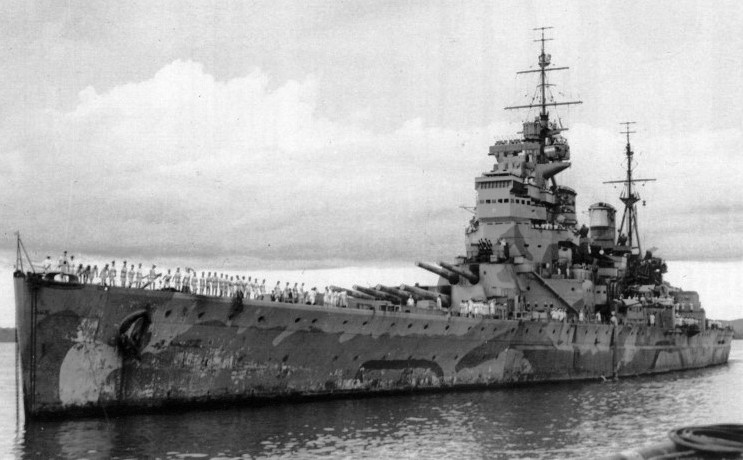
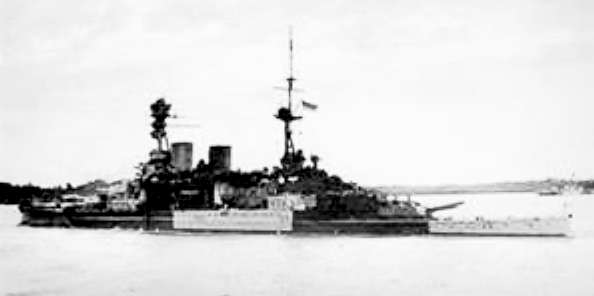 HMS PRINCE OF WALES and REPULSE at Royal Navy Base,
Singapore
10 December 1941:
HMS PRINCE OF WALES and REPULSE at Royal Navy Base,
Singapore
10 December 1941:
Saigon and Thudamot, French Indochina. The Genzan,
Kanoya and Mihoro Kokutai (Naval Air Groups) of Rear Admiral (later Vice
Admiral) Matsunaga Sadaichi's (former CO of ISUZU) 22nd Air Flotilla launch 94
torpedo-bombers (Type 96 Mitsubishi G3M2 "Nell" and Type 1 G4M1 "Betty") that
overwhelm Phillips "Force Z" and sink both HMS PRINCE OF WALES and REPULSE off
Kuantan, Malaya.
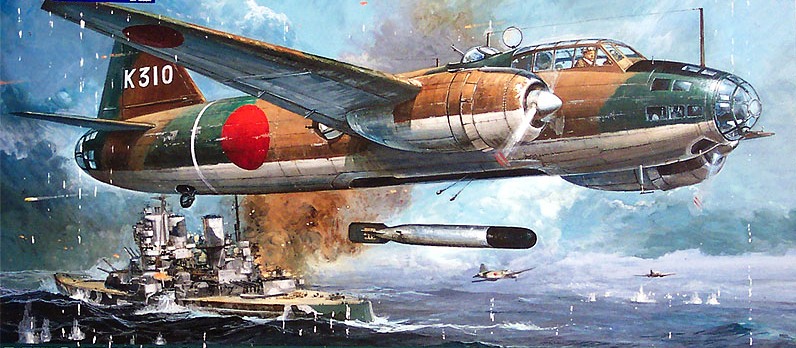
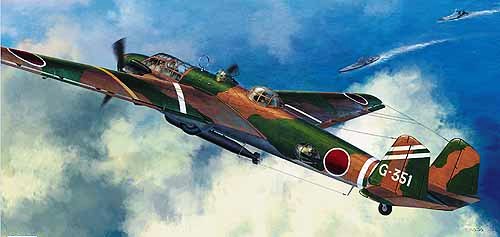 IJN G4M1 Betty (Tamiya) and G3M2 Nell (Hasegawa) torpedo
bombers over Force "Z"
With the impending capture of Singapore by the Imperial Japanese Army in
1942, the King George VI dry dock gates were blown off and machinery destroyed.
The dock was subsequently repaired and used throughout the war. In late 1944
and early 1945 it was subjected to Allied air attacks to disable it.
There was also a floating crane nearby.
27 February 1942:
IJN G4M1 Betty (Tamiya) and G3M2 Nell (Hasegawa) torpedo
bombers over Force "Z"
With the impending capture of Singapore by the Imperial Japanese Army in
1942, the King George VI dry dock gates were blown off and machinery destroyed.
The dock was subsequently repaired and used throughout the war. In late 1944
and early 1945 it was subjected to Allied air attacks to disable it.
There was also a floating crane nearby.
27 February 1942:
Cruiser CHOKAI arrives at Seletar Naval Base.
Drydocked for hull repairs at the IJN No. 101 Repair Facility.
5 March 1942:
Cru Div 7’s MOGAMI, MIKUMA, KUMANO and SUZUYA arrive at
Seletar Naval Base.
9 March 1942:
Cru Div 7 and CHOKAI depart Singapore to cover the
invasion landings at Sabang and Iri, northern Sumatra.
15 March 1942:
Arrives back at Singapore.
20 March 1942:
CruDiv 7 and CHOKAI depart Singapore to support the
seizure of the Andaman Islands.
25 December 1942:
Heavy cruiser ASHIGARA arrives at the Seletar Naval
Base from Surabaya, Java and drydocked. Her hull is scraped and repainted.
2 January 1943:
Undocked.
5 January 1943:
Departs Singapore.
23 July 1943:
At 1600, convoy HI-02, the first of many fast convoys,
departs Seletar for Moji consisting of tanker TATEKAWA MARU and cargo ship
TARUSHIMA MARU escorted by kaibokan SADO.
19 October 1943:
Carrier RYUHO arrives at Seletar from Samah, Hainan,
Island.
22 October 1943:
IJN Submarine I-34 arrives at Seletar Naval Base on a
"Yanagi" mission to Nazi-occupied France. She is the third IJN submarine to
undertake such a mission. Her five passengers, including Rear Admiral Kojima
Hideo (former CO of CL KASHII) and two Mitsubishi engineers, have already
arrived there by plane. Rear Admiral Kojima visits Cdr Irie aboard I-34 to
discuss the details of the sortie. The Japanese code name I-34 "Momi" (Fir) and
the Germans code name her the "U-Tanne". Radio traffic between Tokyo and Berlin
concerning I-34's mission is transmitted in diplomatic code, but is intercepted
and deciphered by Allied code-breakers.

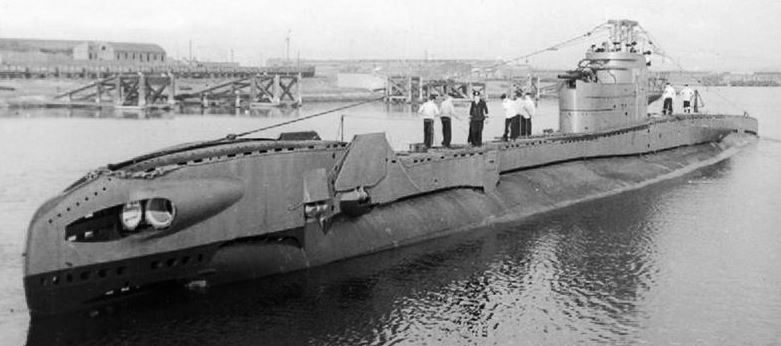 Left: Type B1 submarine similar to I-34 Right: HMS submarine TAURUS
26 October 1943:
Left: Type B1 submarine similar to I-34 Right: HMS submarine TAURUS
26 October 1943:
RYUHO departs Singapore for Kure via Samah.
4 November 1943:
Submarine I-34 embarks a cargo of tin, tungsten, raw
rubber and opium. Tin ingots are inserted into submarine’s keel as ballast,
bales of rubber are loaded below the upper deck planking. Tungsten bars are
loaded to forward and aft crew spaces and opium stored in wooden boxes in the
floatplane hangar. The initial diving tests reveal that the additional cargo has
upset I-34’s trim, preventing crash-dives. Her departure is delayed. Rear
Admiral Kojima and I-34's other passengers decide to take a train and rejoin the
submarine in Penang.
11 November 1943:
Early in the morning I-34 departs Seletar for
Penang.
13 November 1943:
30 miles S of Penang. Alerted by an "Ultra" special
intelligence signal, LtCdr (Later Captain) Mervyn R. G. Wingfield's submarine
HMS TAURUS sights I-34 running on the surface at 14 knots. At 0730, Wingfield
sets up and fires six torpedoes. One hits I-34's starboard side just below her
conning tower. She sinks at 115 feet, 10 nm NW of the Muka lighthouse at 05-17N,
100-05E. Some twenty sailors in the forward crew space survive the attack and
are trapped inside the submarine. CPO Miyake Kazumasa manages to open a deck
hatch, allowing them to escape. Of these, 14 are picked up by a native junk and
arrive at Penang that evening, but 84 crewmembers are KIA. I-34 is the first IJN
submarine sunk by a Royal Navy submarine.
11 March 1944:
Carrier ZUIKAKU and cruiser MOGAMI, en route to
Lingga, put into Seletar Naval Base.
20 March 1944:
Departs Singapore for Lingga.
25 March 1944:
ZUIKAKU arrives at Singapore from Lingga.
26 March 1944:
Enters drydock.
30 March 1944:
Battleship NAGATO arrives at the Seletar Naval Base
from the fleet anchorage at Lingga. Dry-docked in the No. 1 Drydock, (the former
King George VI Drydock) of the No. 101 Repair Facility. Lignum vitae changed.
31 March 1944:
ZUIKAKU is undocked.
3 April 1944:
ZUIKAKU departs Singapore for Lingga.
13 April 1944:
NAGATO is undocked. Takes on fuel and supplies.
Battleship FUSO is dry-docked at No. 1 drydock (former King George V Graving
Dock) for maintenance. Her crew is given liberty in Singapore.
16 April 1944:
NAGATO departs Singapore for Lingga.
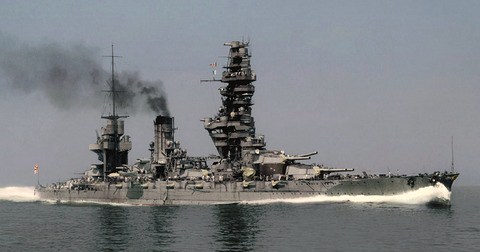
 Left: FUSO Right: NAGATO
21 April-3 May 1944:
Left: FUSO Right: NAGATO
21 April-3 May 1944:
CHOKAI arrives at Seletar Naval Base from Lingga.
Undergoes minor upkeep.
25 April 1944:
FUSO is undocked.
27 April 1944:
FUSO departs Singapore for Lingga.
2 May 1944:
ZUIKAKU is dry-docked.
3 May 1944:
ZUIKAKU is undocked. CHOKAI departs Singapore for Lingga.
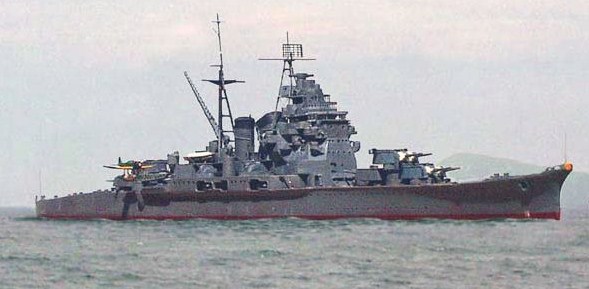
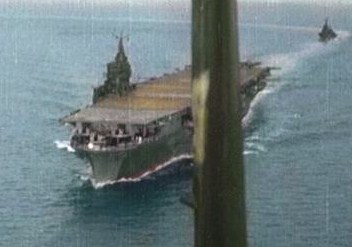 Left: CHOKAI Right: ZUIKAKU
6 May 1944:
Left: CHOKAI Right: ZUIKAKU
6 May 1944:
ZUIKAKU departs Singapore for Lingga.
1-6 October 1944:
NAGATO makes two trips from the fleet anchorage at
Lingga to Seletar Naval Base and return carrying liberty parties. On one trip,
NAGATO is refueled by oiler YUHO MARU at Seletar.
2 October 1944:
At 1400, BatDiv 2’s FUSO and YAMASHIRO arrive at
Seletar Naval Base from Brunei, Borneo en route to Lingga. FUSO refuels from
oiler YUHO MARU
23 October 1944: The Battle of the Palawan
Passage:
At 0634, heavy cruiser TAKAO is hit by two torpedoes from
Cdr (later Captain) David McClintock's DARTER (SS-227), set afire and goes dead
in the water. In the evening, TAKAO gets underway for Brunei with destroyers
NAGANAMI and ASASHIMO, torpedo boat HIYODORI and steamer MITSU MARU.
24 October 1944:- The Battle of the Sibuyan
Sea:
Force A endures eleven raids by over 250 Task Force 38 carrier
aircraft. At 1029, heavy cruiser MYOKO is hit starboard aft by a Mark 13 torpedo
from one of INTREPID’s (CV-11) TBM "Avengers". The torpedo puts MYOKO's
starboard screws out of action, her speed falls off to 15 knots and she drops
out of formation. MYOKO, escorted by KISHINAMI, makes for Coron.
3 November 1944:
MYOKO arrives at Singapore. Begins temporary repairs
at Seletar Naval Base.
5 November 1944:
Seletar Naval Base. 53 USAAF Boeing B-29 “Super
Fortresses”, based near Calcutta, India, bomb and damage the King George VI
Graving Dock. The dry dock is out of service for three months, but MYOKO is not
further damaged in this raid. She continues undergoing temporary repairs.
12 November 1944:
TAKAO arrives at Singapore.
15 November 1944:
TAKAO and MYOKO are deemed unrepairable at Singapore
and impossible to tow to Japan. Both are moored in Seletar harbor as floating AA
batteries.

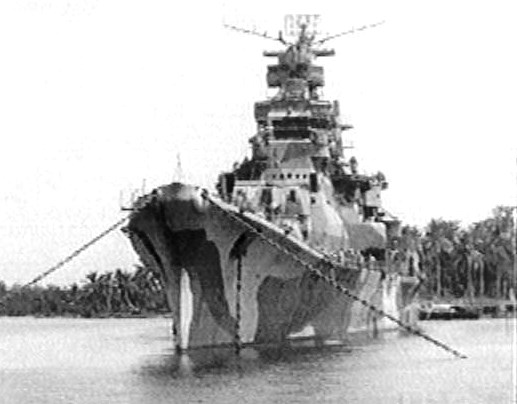 Left: MYOKO at Singapore. Right: TAKAO off Seletar Naval
Base in late 1945
12 December 1944:
Left: MYOKO at Singapore. Right: TAKAO off Seletar Naval
Base in late 1945
12 December 1944:
MYOKO departs Singapore for Japan with destroyer
USHIO. The warships fall in with convoy HI-82 consisting of tankers OMUROSAN,
OTOWASAN, ARITA and PALEMBANG MARUs escorted by kaibokan ETOROFU, SHONAN, KUME,
CD-9 and CD-19.
13 December 1944:
At 2135 hours, MYOKO, enroute to Camranh Bay, is hit
by one of six torpedoes fired by USS BERGALL (SS-320) at 8-10N, 105-31E. She is
set afire and goes dead in the water. Towed on one engine by USHIO towards
Singapore.
1 February 1945:
USAAF Twentieth Air Force on Tinian dispatches 113
B-29s (Mission 33) to hit Seletar. Sixty-seven aircraft bomb the Admiralty IX
Floating Drydock (and oiler SHIRETOKO berthed in it). Twenty-one aircraft bomb
the West Wall area of the base. MYOKO is near-missed astern by bombs.
1 January 1945:
CarDiv 4’s HYUGA, ASHIGARA, OYODO, DesDiv 2's ASASHIMO
and DesDiv 18's KASUMI arrive at Singapore from Camranh Bay, Indochina via Cap
St Jacques. Cruisers ASHIGARA and OYODO are detached for repairs at Seletar
Naval Base. CarDiv 4 continues on to Lingga.
Early February 1945:
MYOKO is drydocked in the King George VI drydock.
7-9 February 1945: Operation Kita ("North"):
Singapore. The "Completion Force" (KAN-Butai) comprised of CarDiv 4’s battleship-carriers
HYUGA and ISE are each loaded with 5,000 drums of aviation gasoline, 100 kiloliters of
aviation gasoline in ship storage tanks, 330 drums of ordinary gasoline, 520 tons of rubber,
820 tons of tin, 50 tons of tungsten and 30 tons of mercury. Light cruiser OYODO takes on
300 tons of rubber, zinc, mercury, tin and gasoline. Desdiv 18's destroyers KASUMI, DesDiv 21's
ASASHIMO and HATSUSHIMO take on 140 tons of rubber and tin. The ships also embark 1,150 oil
field technical personnel.
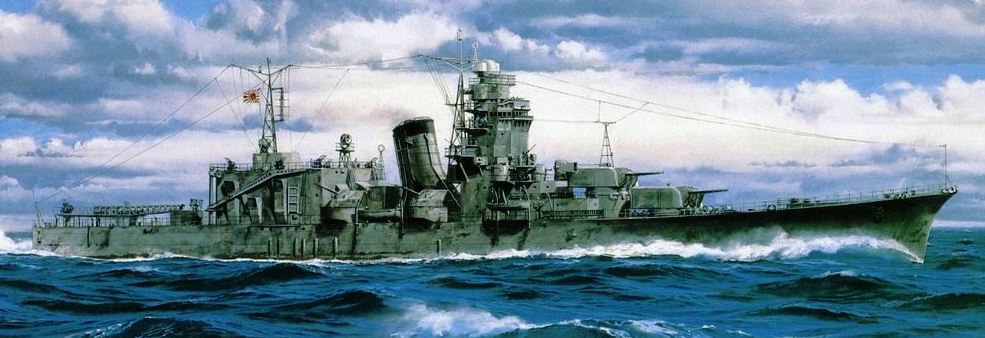
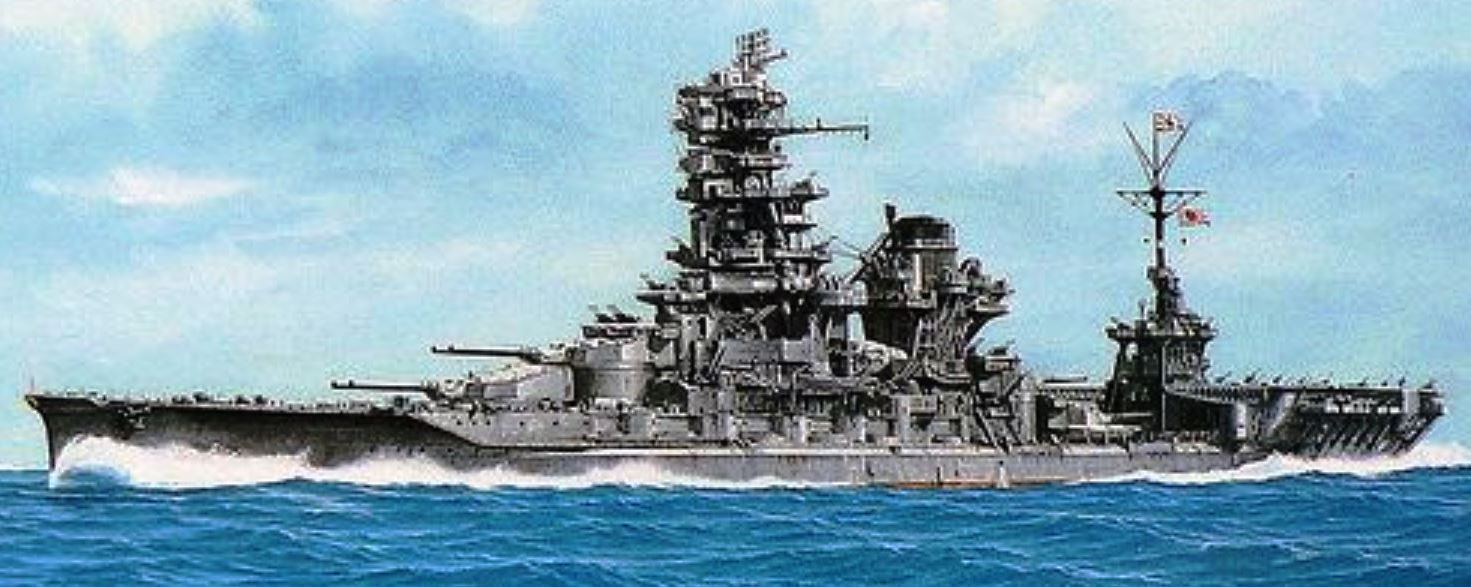 Left: Light cruiser OYODO Right: Battleship-carrier HYUGA
Left: Light cruiser OYODO Right: Battleship-carrier HYUGA
10 February 1945:
At 2100, the Completion Force sorties from Singapore.
20 February 1945:
At 1000, arrives at Kure. En route, the Completion Force escapes
pursuit by 23 American and Allied submarines.
26 July 1945: British Operation "Struggle":
After taking Rangoon,
Burma (now Yangon, Myanmar) the British move towards Singapore. TAKAO and
MYOKO's eight-inch guns pose a threat to any forces that may try to cross the
causeway from Johore, Malaya to Singapore Island. The cruisers could also wreak
havoc with Allied shipping attacking from seaward. Lt G. S. C. Clarabut's
submarine HMS STYGIAN departs Brunei and tows S/Lt Frank Ogden's midget
submarine HMS XE3 towards Singapore. HMS SPARK tows Lt J. E. Smart's HMS XE1 is
assigned to attack MYOKO.
30 July 1945:
At 0600, S/Lt Ogden and his passage crew turn XE3 over
to Lt Ian Fraser and his three-man crew to execute the attack on TAKAO.
31 July 1945:
At 0217, XE3’s main engine is stopped and they creep
past a listening post using the electric motor only. About 0240, Fraser fixes
their position at 8. 3 miles from Johore. He goes ahead on his main engine at
4.5 knots. As XE3 makes her way up the Johore Strait her echo-sounder registers
the depth at thirty feet as she crosses the Johore Shoal. At 0800 they pass
through the boom guarding the harbor. At 1250, TAKAO comes into view. Fraser
maneuvers XE3 under TAKAO with only a foot of water between her and the
cruiser's keel. Leading Seaman Magennis dons his breathing appartus and plants
six limpet mines spread across 45 feet of TAKAO's hull. XE3 drops the two side
cargoes - one full of two tons of high explosive and the other the empty limpet
carrier. The HE charge falls away, but the limpet carrier refuses to budge.
TAKAO slowly settles with the tide. XE-3 is trapped under her bilge keel, but
frees herself from under TAKAO. At 2130, some but not all of the limpet mines
explode and blow a 23 by 10 foot hole in the starboard side of TAKAO's hull. Her
keel buckles, the blast disables her turrets and damages her rangefinder, but
she does not sink. Postwar, it is learned that she was manned by a skeleton crew
and had no ammunition aboard for her 8-inch main armament.
Harbors and Docks:
Keppel Harbor (former New Harbor) is a natural, deepwater harbor at
Tanjong Pagar, where Singapore Harbor is situated. The Empire, Albert and
Victoria Docks were commercial docks. The Empire Dock was the largest of the
commercial docks and lies opposite Pulau Bran island. Prewar, large ocean liners
and cargo ships used these docks and others. Further west was the Keppel Harbor
Oil Terminal, Kings Dock, and Main Wharf.
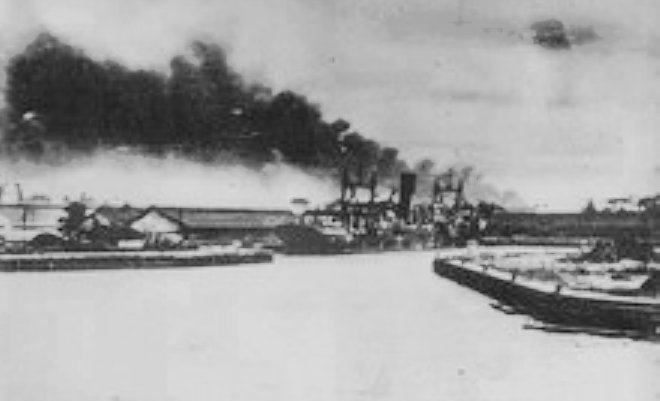
 Left: Empire Docks burning. Right: Japanese troops at
Empire Docks celebrating the surrender of Singapore.
Oil Refineries:
The Pulau Bukom oil refinery lies south of Pulau Blakang Mati. The Pulau
Sebarok refinery is east of Pulau Bukum. The Pulau Sambu refinery also was
nearby, but in Dutch East Indies territory.
Left: Empire Docks burning. Right: Japanese troops at
Empire Docks celebrating the surrender of Singapore.
Oil Refineries:
The Pulau Bukom oil refinery lies south of Pulau Blakang Mati. The Pulau
Sebarok refinery is east of Pulau Bukum. The Pulau Sambu refinery also was
nearby, but in Dutch East Indies territory.
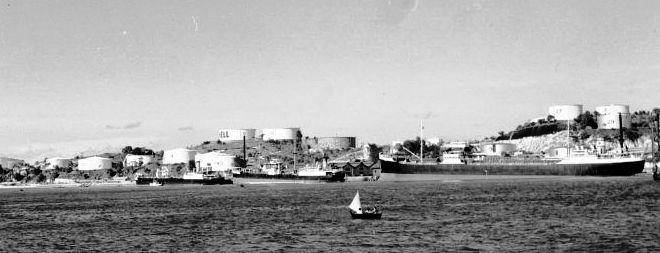
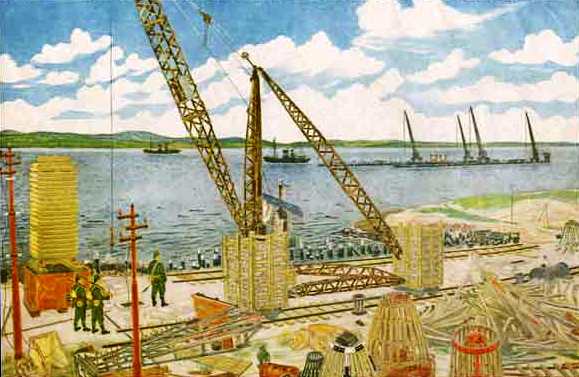 Left: Shell Oils Pulau Sambu refinery in 1936. Right:
Japanese troops at Singapore Dock
Military and Civil Air and Seaplane Bases:
RAF Seletar
In 1923, the Royal Air Force approved two sites in the northern part of
Singapore Island for clearing and construction of an airfield, flying boat and
naval base. On 28 February 1928, four Supermarine Southampton seaplanes were the
first planes to arrive at Seletar. The base, known as RAF Seletar served as a
civil airport from 1930 until the late 1940s. When the Japanese launched their
invasion of Malaya and Singapore, Seletar housed the RAF’s 205 Squadron with
Conolidated PBY "Catalina" flying boats and 36th and 100th Squadrons with
obsolete Vickers "Vildebeest" torpedo bombers (including five Fairey "Albacore"s
acquired by 36th Squadron to supplement its Vildebeests), along with the 151st
Maintenance Unit. These units stayed until Jan-Feb 1942, just before the British
surrendered to the Japanese. RAF Seletar was abandoned when the Japanese took
Johore Bahru and brought their artillery in range of the airfield.
Left: Shell Oils Pulau Sambu refinery in 1936. Right:
Japanese troops at Singapore Dock
Military and Civil Air and Seaplane Bases:
RAF Seletar
In 1923, the Royal Air Force approved two sites in the northern part of
Singapore Island for clearing and construction of an airfield, flying boat and
naval base. On 28 February 1928, four Supermarine Southampton seaplanes were the
first planes to arrive at Seletar. The base, known as RAF Seletar served as a
civil airport from 1930 until the late 1940s. When the Japanese launched their
invasion of Malaya and Singapore, Seletar housed the RAF’s 205 Squadron with
Conolidated PBY "Catalina" flying boats and 36th and 100th Squadrons with
obsolete Vickers "Vildebeest" torpedo bombers (including five Fairey "Albacore"s
acquired by 36th Squadron to supplement its Vildebeests), along with the 151st
Maintenance Unit. These units stayed until Jan-Feb 1942, just before the British
surrendered to the Japanese. RAF Seletar was abandoned when the Japanese took
Johore Bahru and brought their artillery in range of the airfield.
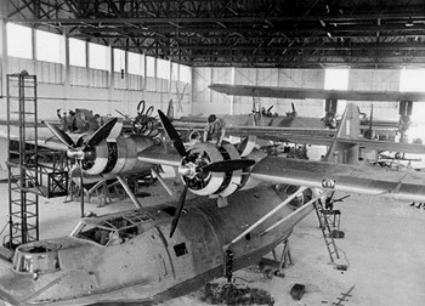
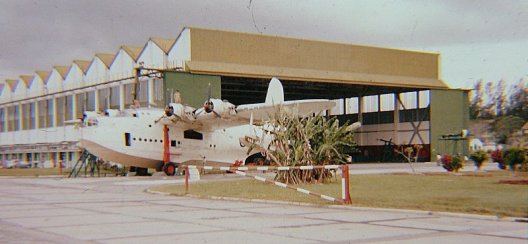 Left: PBY "Catalina" at Seletar. Right: Short Sunderland
flying boat at Seletar
On 14 February, 1942, a small detachment of the IJN's No. 10 Naval Base
Unit arrived at abandoned Seletar. Then on 15 February, Captain Sawai Hideo's
101 st Maintenance and Supply Unit arrived to begin restoring the airfield. Part
of the 40th Kokutai (Naval Air Group) arrived on 25 February. The CO of the 40th
NAG, Captain Furuta Yoshio, arrived the next day.
On 8 March 1942, the first Japanese aircraft were able to land at Seletar
- two Mitsubishi Type 97 "Betty" bombers needed for patrol work in the Burma
campaign.
During the Japanese occupation of Singapore from 1942 through 1945, a
number of IJN squadrons were based, or transited through, Seletar mainly for
training. Among these units were the 936th NAG equipped with Nakajima B5N
"Kate", Aichi D3A "Val", Aichi E13A1 "Jake" and Nakajima A6M2-N “Rufe” float
fighters. The 381st NAG was also based there with Mitsubishi A6M "Zeke" and
Mitsubishi J2M "Jack" fighters. In early 1944, the 601st NAG was there for
training before its destruction on board Carrier Division 1’s TAIHO, SHOKAKU and
ZUIKAKU during the Battle of Philippine Sea (Marianas Turkey Shoot) in June
1944.
Left: PBY "Catalina" at Seletar. Right: Short Sunderland
flying boat at Seletar
On 14 February, 1942, a small detachment of the IJN's No. 10 Naval Base
Unit arrived at abandoned Seletar. Then on 15 February, Captain Sawai Hideo's
101 st Maintenance and Supply Unit arrived to begin restoring the airfield. Part
of the 40th Kokutai (Naval Air Group) arrived on 25 February. The CO of the 40th
NAG, Captain Furuta Yoshio, arrived the next day.
On 8 March 1942, the first Japanese aircraft were able to land at Seletar
- two Mitsubishi Type 97 "Betty" bombers needed for patrol work in the Burma
campaign.
During the Japanese occupation of Singapore from 1942 through 1945, a
number of IJN squadrons were based, or transited through, Seletar mainly for
training. Among these units were the 936th NAG equipped with Nakajima B5N
"Kate", Aichi D3A "Val", Aichi E13A1 "Jake" and Nakajima A6M2-N “Rufe” float
fighters. The 381st NAG was also based there with Mitsubishi A6M "Zeke" and
Mitsubishi J2M "Jack" fighters. In early 1944, the 601st NAG was there for
training before its destruction on board Carrier Division 1’s TAIHO, SHOKAKU and
ZUIKAKU during the Battle of Philippine Sea (Marianas Turkey Shoot) in June
1944.
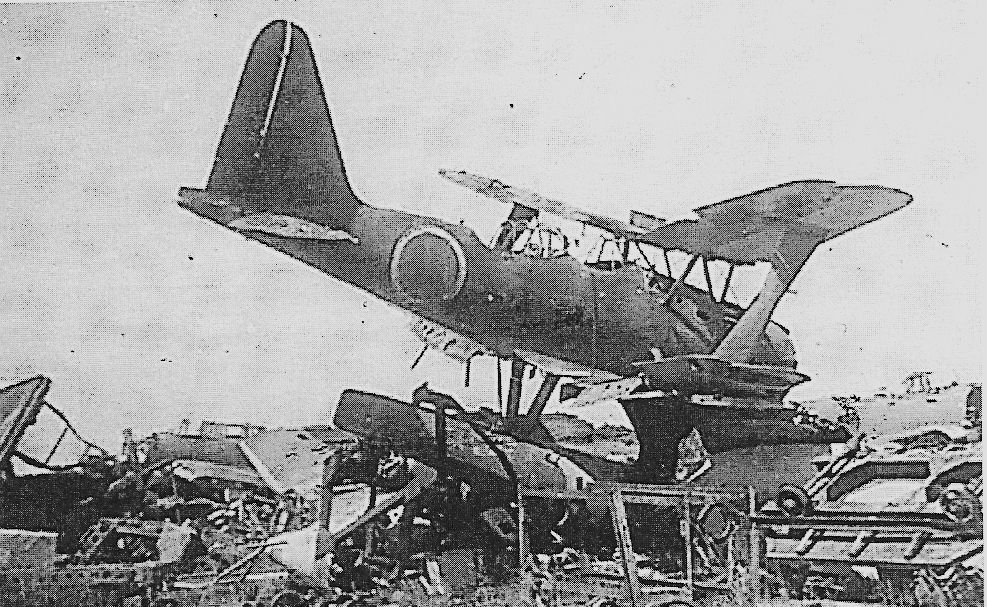
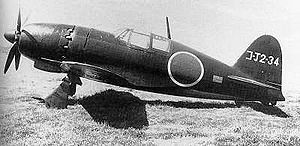 Left: Mitsubishi F1M2 “Pete” seaplane on the scrap pile at
Seletar postwar. Right: Wartime Mitsubishi J2M "Jack" fighter.
Left: Mitsubishi F1M2 “Pete” seaplane on the scrap pile at
Seletar postwar. Right: Wartime Mitsubishi J2M "Jack" fighter.
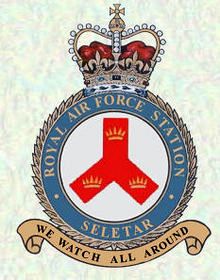
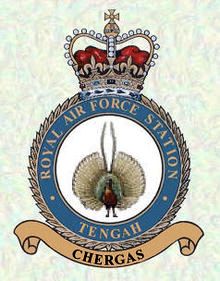 Crests of RAF Seletar and RAF Tengah
RAF Tengah
In 1939, RAF Tengah was commissioned. In December 1941, shortly after the
Battle of Malaya began, Tengah airfield was the target of carpet bombing when 17
IJNAF bombers conducted the first air raid on Singapore. It also was the first
airfield to be captured when Japanese forces invaded. After the fall of
Singapore, Tengah came under the control of the Imperial Japanese Army Air Force
(IJAAF). The IJAAF's 13th Hiko Sentai (Flying Regiment) equipped with Kawanishi
Ki-4 II & III “Oscar” fighters, Kawanishi KI-84 “Frank” fighters was based
at Tengah from April 1944 to August 1945 and 31st Sentai with Kawanishi Ki-61
“Tony” fighters was there from May 1945 until August 1945.
Crests of RAF Seletar and RAF Tengah
RAF Tengah
In 1939, RAF Tengah was commissioned. In December 1941, shortly after the
Battle of Malaya began, Tengah airfield was the target of carpet bombing when 17
IJNAF bombers conducted the first air raid on Singapore. It also was the first
airfield to be captured when Japanese forces invaded. After the fall of
Singapore, Tengah came under the control of the Imperial Japanese Army Air Force
(IJAAF). The IJAAF's 13th Hiko Sentai (Flying Regiment) equipped with Kawanishi
Ki-4 II & III “Oscar” fighters, Kawanishi KI-84 “Frank” fighters was based
at Tengah from April 1944 to August 1945 and 31st Sentai with Kawanishi Ki-61
“Tony” fighters was there from May 1945 until August 1945.
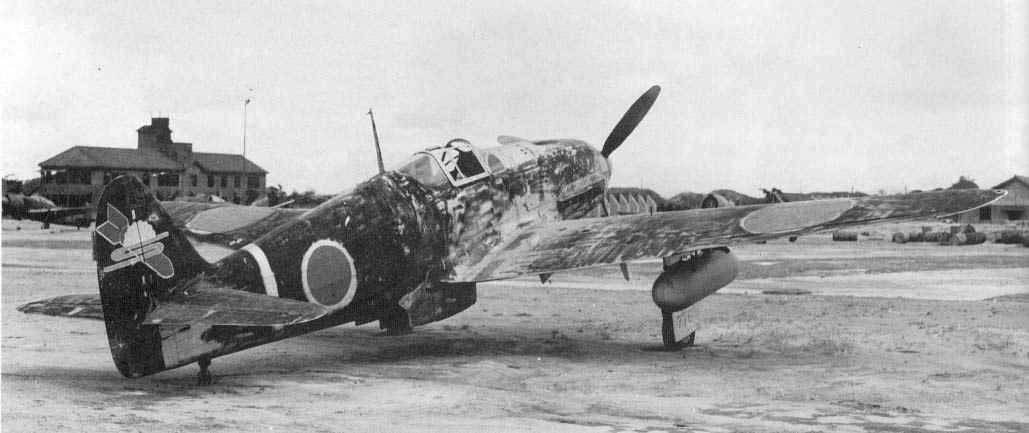
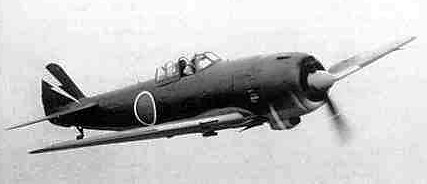 Ki-61 “Tony” and KI-84 “Frank” IJAAF fighters
RAF Sembawang
In March 1940, the Royal Navy's RAF Sembawang (also known as HMS Simbang)
was completed. Later, RAF No. 453 Squadon, equipped with obsolete Brewster
"Buffalo" fighters, was based there. In February 1942, RAF Sembawang was
partially torched and wrecked by the retreating British to deny its use to the
invading Japanese. in 1945, after the end of World War II, the base reverted to
British control.
RAF Changi
In 1940, Changi was first completed as a British artillery camp. After
the fall of Singapore in 1942, it and nearby Changi Prison were used for housing
many of the Allied prisoners-of-war (POWs). The construction of the air base was
initiated by Japanese forces using the Allied POWs as forced laborers. Between
1943 and 1944 they built two unpaved landing strips intersecting in a cross
layout in an approximate north-south and east-west direction. In 1946, after the
Japanese surrender, the airfield became a Royal Air Force station and was
renamed RAF Changi. Imprisoned Japanese troops were made to improve the runways,
reinforce the north-south runway for military aircraft and add perforated steel
plates to the east-west runway.
Ki-61 “Tony” and KI-84 “Frank” IJAAF fighters
RAF Sembawang
In March 1940, the Royal Navy's RAF Sembawang (also known as HMS Simbang)
was completed. Later, RAF No. 453 Squadon, equipped with obsolete Brewster
"Buffalo" fighters, was based there. In February 1942, RAF Sembawang was
partially torched and wrecked by the retreating British to deny its use to the
invading Japanese. in 1945, after the end of World War II, the base reverted to
British control.
RAF Changi
In 1940, Changi was first completed as a British artillery camp. After
the fall of Singapore in 1942, it and nearby Changi Prison were used for housing
many of the Allied prisoners-of-war (POWs). The construction of the air base was
initiated by Japanese forces using the Allied POWs as forced laborers. Between
1943 and 1944 they built two unpaved landing strips intersecting in a cross
layout in an approximate north-south and east-west direction. In 1946, after the
Japanese surrender, the airfield became a Royal Air Force station and was
renamed RAF Changi. Imprisoned Japanese troops were made to improve the runways,
reinforce the north-south runway for military aircraft and add perforated steel
plates to the east-west runway.
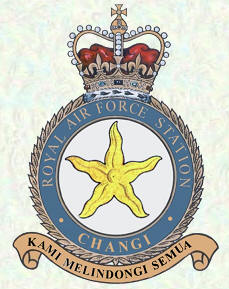 Crest of RAF Changi
Kallang Civil Airport/RAF Kallang
In 1932, reclamation work began in Kallang Basin to turn the swampy area
into a circular-shaped airfield and slipway for seaplanes. On 12 June 1937,
Singapore's first purpose-built civil airport was opened at Kallang together
with a seaplane anchorage. The circular airfield allowed planes to land from any
direction, and the slipway allowed seaplanes to be served at the same terminal
building as regular planes.
On 12 March 1941, Squadron RAF reformed at RAF Kallang equipped with
Brewster "Buffalo" fighters On 8 December 1941, When the Japanese launched their
invasion of Malaya and Singapore, RAF Kallang was the principal fighter
airfield. By January 1942, it was the only operational fighter airfield in
Singapore, as RAF Seletar, RAF Sembawang and RAF Tengah airfields were within
range of Japanese artillery at Johore Bahru. Brewster "Buffalo" fighters of 243 Squadron
RAF, 488 Squadron Royal New Zealand Air Force (RNZAF) and a detachment of
2-VLG-V of the Royal Netherlands East Indies Air Force operated from the
airfield. Later, they were joined by Hawker "Hurricanes" of 232 Squadron RAF.
Crest of RAF Changi
Kallang Civil Airport/RAF Kallang
In 1932, reclamation work began in Kallang Basin to turn the swampy area
into a circular-shaped airfield and slipway for seaplanes. On 12 June 1937,
Singapore's first purpose-built civil airport was opened at Kallang together
with a seaplane anchorage. The circular airfield allowed planes to land from any
direction, and the slipway allowed seaplanes to be served at the same terminal
building as regular planes.
On 12 March 1941, Squadron RAF reformed at RAF Kallang equipped with
Brewster "Buffalo" fighters On 8 December 1941, When the Japanese launched their
invasion of Malaya and Singapore, RAF Kallang was the principal fighter
airfield. By January 1942, it was the only operational fighter airfield in
Singapore, as RAF Seletar, RAF Sembawang and RAF Tengah airfields were within
range of Japanese artillery at Johore Bahru. Brewster "Buffalo" fighters of 243 Squadron
RAF, 488 Squadron Royal New Zealand Air Force (RNZAF) and a detachment of
2-VLG-V of the Royal Netherlands East Indies Air Force operated from the
airfield. Later, they were joined by Hawker "Hurricanes" of 232 Squadron RAF.
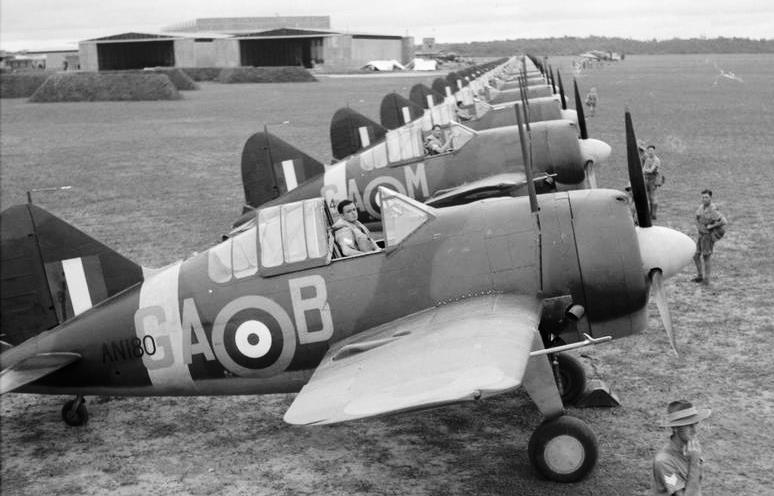
 Buffalo and Hurricane fighters at Singapore
By the end of January 1942, the airfield had been badly damaged by bombing and only
a small number of aircraft were serviceable. On 9 February 1942, air defense of
Singapore ended and the last of the eight "Hurricanes" flew from Kallang to
Palembang, Sumatra just before Singapore was surrendered.
Buffalo and Hurricane fighters at Singapore
By the end of January 1942, the airfield had been badly damaged by bombing and only
a small number of aircraft were serviceable. On 9 February 1942, air defense of
Singapore ended and the last of the eight "Hurricanes" flew from Kallang to
Palembang, Sumatra just before Singapore was surrendered.
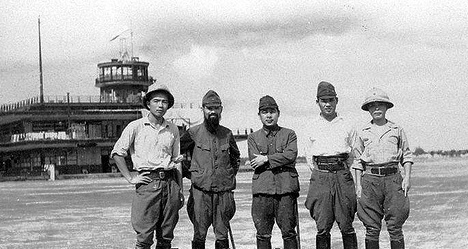
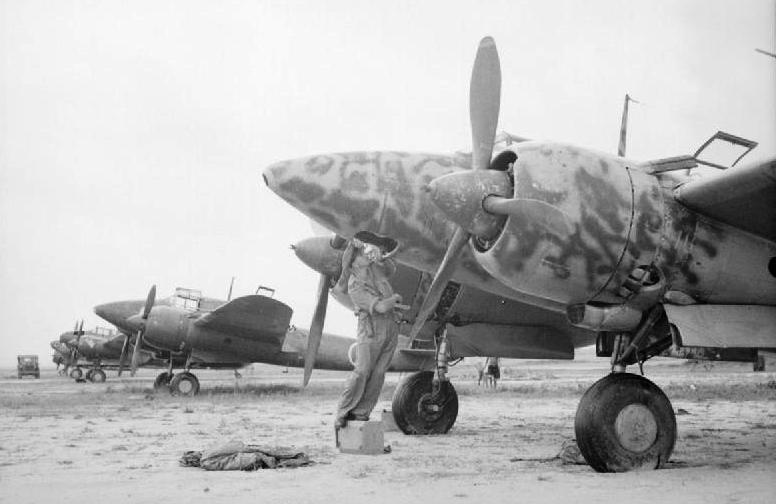 Japanese officers at Kallang and Ki-45 “Nick” night
fighters at Kallang, postwar
During the war, the airport was under the jurisdiction of the Imperial
Army Air Force and the IJAAF's 71st Dokuritsu Hiko Chutai equipped with
Kawanishi Ki-45 “Nick” night fighters was based there. When the new Singapore
International Airport at Paya Lebar was completed on 20 August 1955, Kallang
Airport was closed.
Singapore's Big Gun Fortifications:
Five British BL 15-inch (381 mm) Mark I coastal guns were mounted in
Singapore. The guns were the largest installed outside Britain during World War
II. Three guns formed Changi’s Johore battery built in 1939 to defend the
approaches to the Naval Base at Sembawang and two guns were in the Buona Vista
Battery. The guns of the Johore Battery were in full-traverse armored mounts,
with ammunition magazines buried deep beneath them. A narrow-gauge railway
connected the batteries to further stores of ammunition in a network of tunnels.
There were also four 6-inch rifles. The big guns were designed as anti-ship
weapons and were supplied with armor-piercing (AP) ammunition, but few
high-explosive (HE) ammunition for use against ground troops. While the AP
shells would explode after penetrating a ship’s armor, but when used against
land targets, they would bury deeply in the ground before detonating. The big
gun batteries also lacked effective fire control and communications.
Japanese officers at Kallang and Ki-45 “Nick” night
fighters at Kallang, postwar
During the war, the airport was under the jurisdiction of the Imperial
Army Air Force and the IJAAF's 71st Dokuritsu Hiko Chutai equipped with
Kawanishi Ki-45 “Nick” night fighters was based there. When the new Singapore
International Airport at Paya Lebar was completed on 20 August 1955, Kallang
Airport was closed.
Singapore's Big Gun Fortifications:
Five British BL 15-inch (381 mm) Mark I coastal guns were mounted in
Singapore. The guns were the largest installed outside Britain during World War
II. Three guns formed Changi’s Johore battery built in 1939 to defend the
approaches to the Naval Base at Sembawang and two guns were in the Buona Vista
Battery. The guns of the Johore Battery were in full-traverse armored mounts,
with ammunition magazines buried deep beneath them. A narrow-gauge railway
connected the batteries to further stores of ammunition in a network of tunnels.
There were also four 6-inch rifles. The big guns were designed as anti-ship
weapons and were supplied with armor-piercing (AP) ammunition, but few
high-explosive (HE) ammunition for use against ground troops. While the AP
shells would explode after penetrating a ship’s armor, but when used against
land targets, they would bury deeply in the ground before detonating. The big
gun batteries also lacked effective fire control and communications.
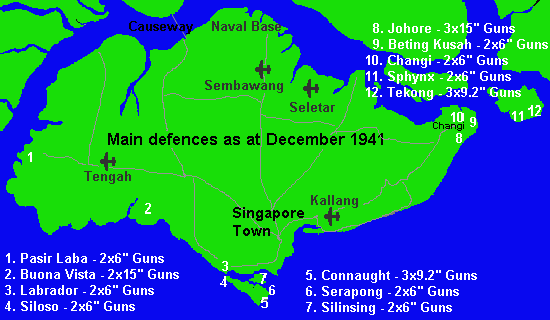
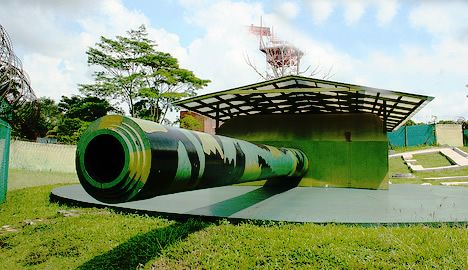 Left: Map of prewar gun defenses Right: Johore Battery
15-inch gun
The Johore Battery guns were destroyed before the surrender of the
British army. One of Buona Vista's 15-inch guns had an arc of fire of only 180 degrees,
although the other had full traverse. As a result, these main guns saw no action
during the Battle of Singapore and were partially destroyed in February
1942 by the retreating British. During their occupation of Singapore, the
Japanese repaired the Number 2 gun.
Several batteries dotted Keppel Harbor and Blakang Mati Island at the
southern tip of Singapore. Eight 6-inch guns and three 9.2-inch guns were sited
here, mostly in upgraded coastal forts dating from the late 19th century.
Finally, on Puland Takau Besar in the Johore Strait two 6-inch and three
9.2-inch guns were sited.
Japan Surrenders:
2 September 1945:
Left: Map of prewar gun defenses Right: Johore Battery
15-inch gun
The Johore Battery guns were destroyed before the surrender of the
British army. One of Buona Vista's 15-inch guns had an arc of fire of only 180 degrees,
although the other had full traverse. As a result, these main guns saw no action
during the Battle of Singapore and were partially destroyed in February
1942 by the retreating British. During their occupation of Singapore, the
Japanese repaired the Number 2 gun.
Several batteries dotted Keppel Harbor and Blakang Mati Island at the
southern tip of Singapore. Eight 6-inch guns and three 9.2-inch guns were sited
here, mostly in upgraded coastal forts dating from the late 19th century.
Finally, on Puland Takau Besar in the Johore Strait two 6-inch and three
9.2-inch guns were sited.
Japan Surrenders:
2 September 1945:
Tokyo Bay. The Japanese formally surrender to the Allies by signing the Instrument of
Surrender aboard USS MISSOURI (BB-63). Immediately following the signing ceremony,
United States General of the Army Douglas MacArthur, Supreme Commander for the Allied Powers
(SCAP), issues General Order No. 1 for the surrender of all Japanese forces.
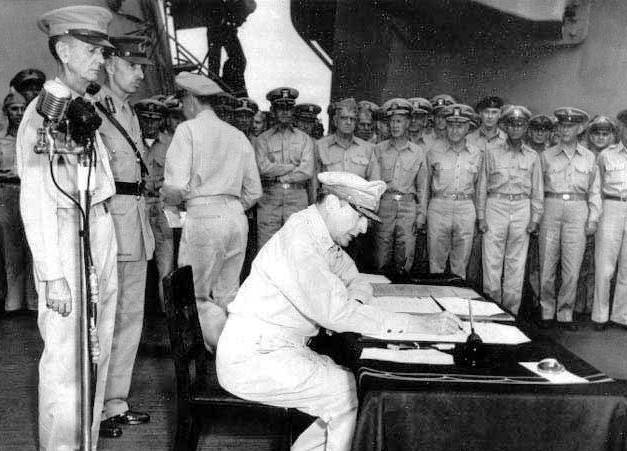
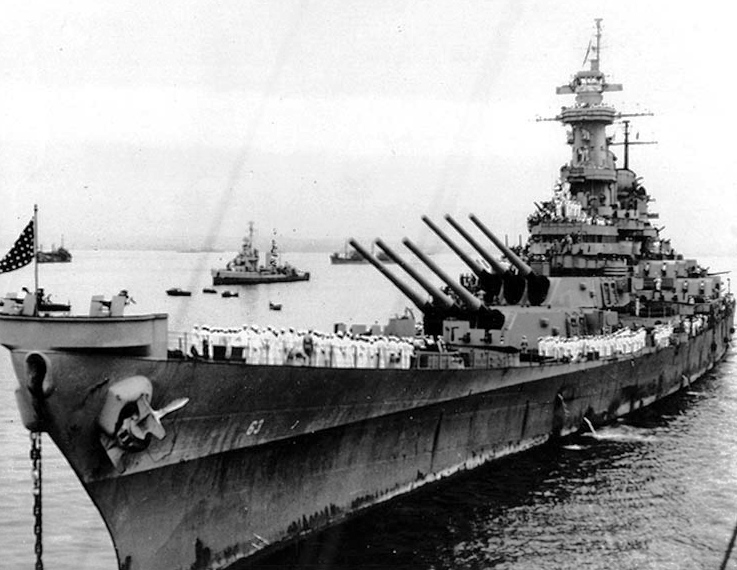 ">
Left: General MacArthur, flanked by LtGens Wainwright of Corregidor and
Pervival of Singapore, signs the Allied Powers Instrument of Surrender Right: USS MISSOURI
in Tokyo Bay
12 September 1945:
">
Left: General MacArthur, flanked by LtGens Wainwright of Corregidor and
Pervival of Singapore, signs the Allied Powers Instrument of Surrender Right: USS MISSOURI
in Tokyo Bay
12 September 1945:
Ten days later, another surrender ceremony is held at Singapore’s
Municipal Building (now City Hall), marking the end of Japanese Occupation in Southeast Asia.
The Allied delegation is led by Admiral (later Admiral of the Fleet) Lord Louis Mountbatten
(Supreme Allied Commander, South East Asia). Other Allied representatives include Admiral
(later Admiral of the Fleet) Sir Arthur Power (Commander-in Chief, East Indies Fleet)
and General (later Field Marshal) Sir William Slim (Commander-in-Chief, Allied Land Forces
South-East Asia [ALFSEA]).

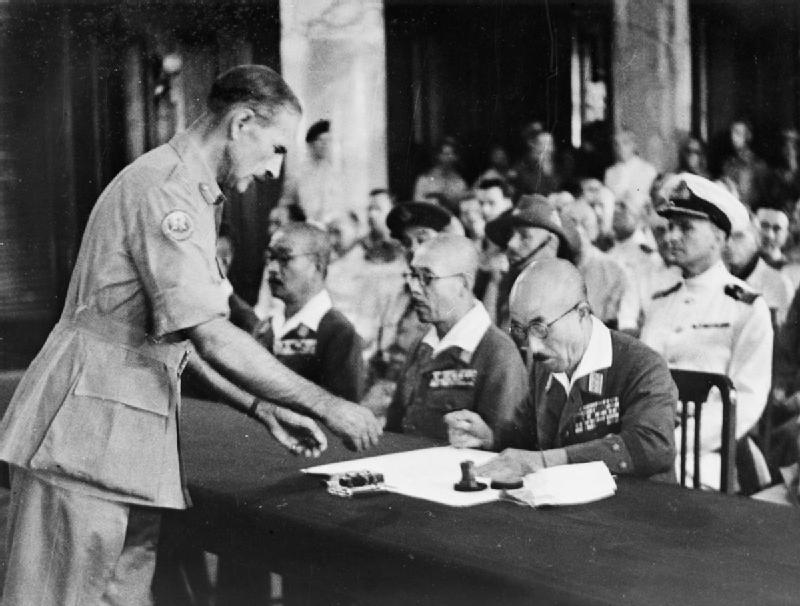 Left: Admiral Mountbatten presides ofter the Surrender
ceremony at Singapore. Right: General Itagaki signs the Instrument of Surrender
The Instrument of Surrender is signed by General Itagaki Seishiro, (CG,
IJA 7th Area Army) who signs on behalf of Field Marshall Count Terauchi
Hisaichi, Supreme Commander of the Imperial Japanese Forces, Southern Region.
Terauchi is unable to attend due to a stroke.
30 September 1945:
Left: Admiral Mountbatten presides ofter the Surrender
ceremony at Singapore. Right: General Itagaki signs the Instrument of Surrender
The Instrument of Surrender is signed by General Itagaki Seishiro, (CG,
IJA 7th Area Army) who signs on behalf of Field Marshall Count Terauchi
Hisaichi, Supreme Commander of the Imperial Japanese Forces, Southern Region.
Terauchi is unable to attend due to a stroke.
30 September 1945:
Saigon, Indochina. Field Marshal Count Terauchi Hisaichi, Supreme Commander of the Imperial Japanese Forces,
Southern Region surrenders personally to Mountbatten. He also surrenders a short sword (wakizashi) forged in the
15th century and a long sword (tachi) dated 1292 a.d. Mountbatten later presents the short sword to King George VI
which is now in Windsor Castle.
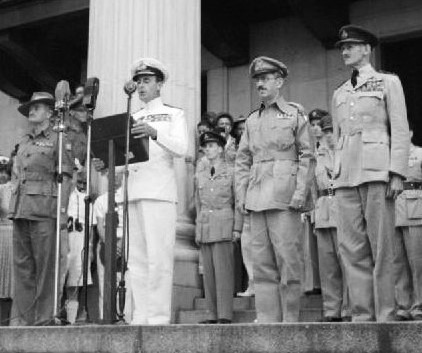
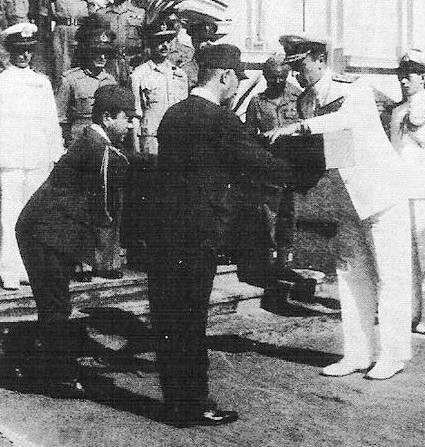 Left: Singapore. Supreme Allied Commander SEA Admiral Lord Louis Mountbatten addressing troops flanked by (left) General
(later Field Marshal), LtGen William J. Slim, C-in-C Allied Land Forces, (right) Deputy Supreme Allied Commander
SEA LtGen Raymond Wheeler, USA and (far right) Air Chief Marshal Sir Keith Park, RAF, Allied Air Commander SEA.
Right: Saigon. Field Marshal Terauchi surrenders his swords to Mountbatten.
Left: Singapore. Supreme Allied Commander SEA Admiral Lord Louis Mountbatten addressing troops flanked by (left) General
(later Field Marshal), LtGen William J. Slim, C-in-C Allied Land Forces, (right) Deputy Supreme Allied Commander
SEA LtGen Raymond Wheeler, USA and (far right) Air Chief Marshal Sir Keith Park, RAF, Allied Air Commander SEA.
Right: Saigon. Field Marshal Terauchi surrenders his swords to Mountbatten.
Author's Note:
In the 1970's, I had the privilege of being the first
non-diplomatic USAF officer to be assigned to Singapore. My job as commander of the
USAF detachment there was to oversee all aspects of aircraft maintenance services
including flight testing performed by Lockheed Air Service Singapore (LASS), Pte, Ltd. at
Republic of Singapore Armed Forces (RSAF) Seletar and Changi Air Bases under USAF,
USN and USA contracts. The aircraft included many series of the venerable Lockheed
C-130 "Hercules" then in use by the USAF, USN, USMC, VNAF and Indonesian Air Forces
as well as USAF and USN Lockheed RC-121 and C-121 "Constellation" reconnaisance aircraft
and USA Beechcraft U-21A/RU-21 "King Air" utility and radio relay aircraft from
Vietnam. Lockheed also operated an air cargo and passenger services terminal for
C-141 "Starlifter" aircraft from Clark AB, Phillipines at Changi Air Base (now
Singapore's ultra-modern commercial airport).
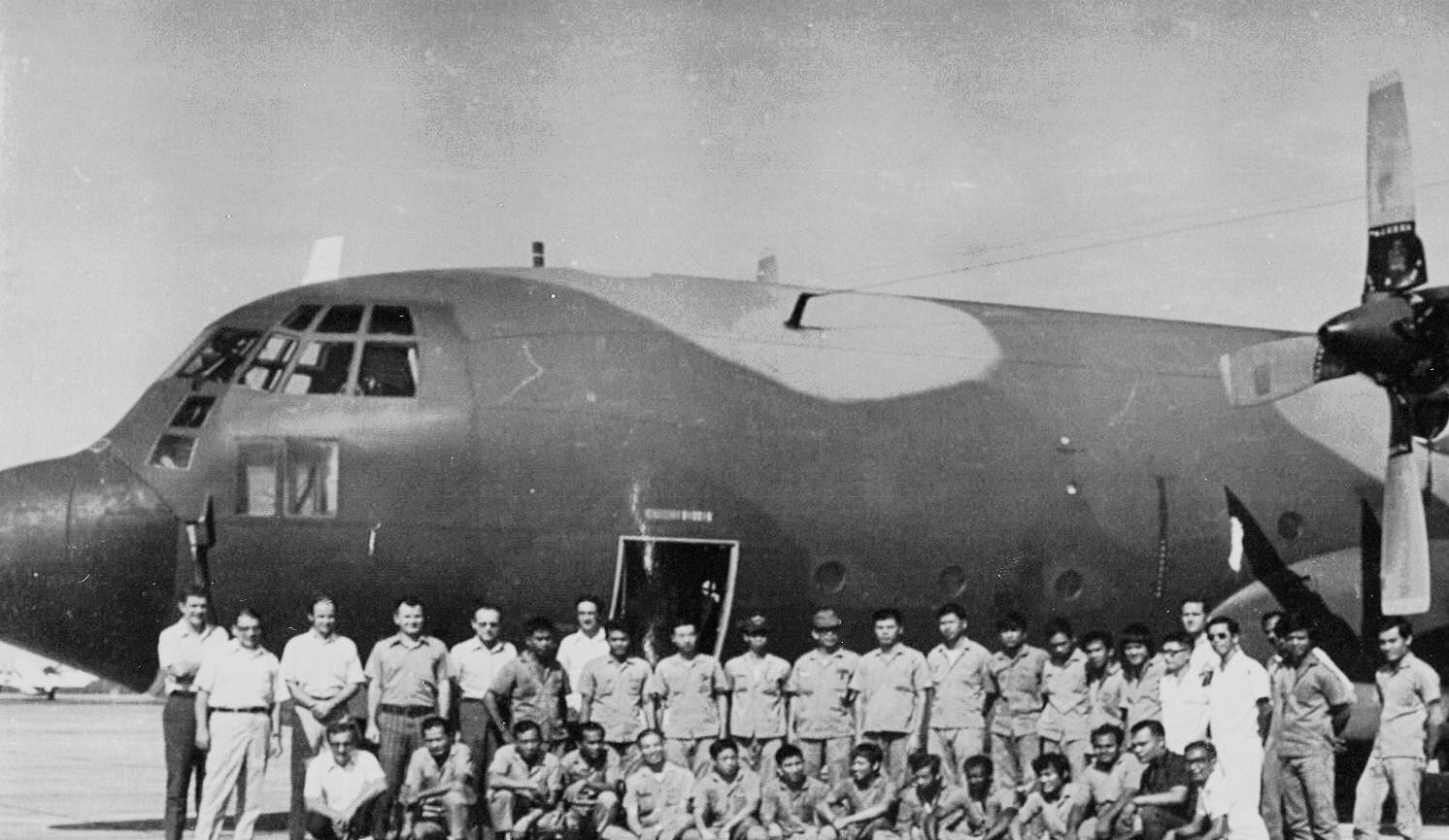 Major (later Colonel) Bob Hackett, at left, and USAF detachment personnel
accepting
Major (later Colonel) Bob Hackett, at left, and USAF detachment personnel
accepting
a PACAF C-130E completing maintenance at Seletar AB by the LASS personnel shown.
By an odd quirk of fate, 30 years later my LtCol (later Colonel) son assumed command of the
detachment in Singapore which by then had migrated from the USAF to the Department of Defense.
He was based at RSAF Paya Lebar AB (Singapore's ex-commercial airport) with responsibility for
contract facilities in Singapore and Malaysia. My wife and I were lucky enough to be able to
visit him and were amazed at how much Singapore had changed since our years there - now there
are expressways and even subways - but it remains the verdant jewel of the Orient.
-Bob Hackett





















































 ">
">





